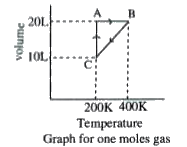Two mole of an ideal gas is heated at constant pressure of one atmosphere from 27∘C to 127∘C. If Cv,m=20+10−2TJK−1mol−1, then q and ΔU for the process are respectively.Solution in Telugu
6362.8J, 4700J
1522.2 Cal, 1124.4 Cal
7062.8 5400J
3181.4J 2350J
The correct Answer is:A, B, C
Δu=nCvdT=T2∫T1n(20+10−2T)dT
=2[20(T2−T1)+10−2[T22−T212]]
=2[20(100)+10−2(400)2−(300)22]]
= 4700J
Work done =−Pext(V2−V1)
=−1nT2RP−nT1RP=−nR.ΔT
=2×8.314×100=−1662.8J From first law of Thermodynamics Δu=Q+w
4700=Q−(1662.8)⇒Q=6363.8J
Topper's Solved these Questions
- CHEMICAL THERMODYNAMICSBook:AAKASH SERIESChapter:CHEMICAL THERMODYNAMICSExercise:LECTURE SHEET (EXERCISE-I) (LEVEL - II (ADVANCED) LINKED COMPREHENSION TYPE QUESTIONS)
Explore 5 Videos
- CHEMICAL THERMODYNAMICSBook:AAKASH SERIESChapter:CHEMICAL THERMODYNAMICSExercise:LECTURE SHEET (EXERCISE-I) (LEVEL - II (ADVANCED) MATRIX MATCHING TYPE QUESTIONS)
Explore 1 Video
- CHEMICAL THERMODYNAMICSBook:AAKASH SERIESChapter:CHEMICAL THERMODYNAMICSExercise:LECTURE SHEET (EXERCISE-I) (LEVEL - II (ADVANCED) STRAIGHT OBJECTIVE TYPE QUESTIONS)
Explore 5 Videos
- CHEMICAL THERMODYANMICS Book:AAKASH SERIESChapter:CHEMICAL THERMODYANMICS Exercise:Questions For Descriptive Answers
Explore 28 Videos
- ELECTRON MIGRATION EFFECTS Book:AAKASH SERIESChapter:ELECTRON MIGRATION EFFECTS Exercise:QUESTIONS FOR DESCRIPTIVE ANSWERS
Explore 10 Videos
Similar Questions

Process A→B represents
View SolutionMatch the following columns

View SolutionWhich has maximum internal energy at 298K?
View SolutionHow does heat of neutralisation value change with the chemical nature of acid and base?
View SolutionHyperconjugation effect is also termed as 'no bond resonance'. Why?
View SolutionOne mole of an ideal monoatomic gas is heated at a constant pressure of 1 atmosphere from 0^(@) C to 100^(@0 C. Work done by the gas is
View Solution3.0 moles of ideal gas is heated at constant pressure from 27^(@)C to 127^(@)C . Then the work expansion of gas is
View SolutionIf one mole of an ideal gas with C_(v) = (3)/(2) R is heated at a constant pressure of 1 atm 25^(@)C to 100^(@)C . Which is correct
View SolutionTwo mole of an ideal gas is heated at constant pressure of one atmosphere from 27∘C to 127∘C. If Cv,m=20+10−2T JK−1.mol−1, then q and ΔU for the process are respectively:
View Solution10 mole of an ideal gas is heated at constant pressure of one atmosphere from 27∘C to 127∘C. If Cv,m=21.686+10−3T(JK−1.mol−1), then ΔH for the process is :
View SolutionTwo moles of an ideal gas initially at 27^(@)C and one atmospheric pressure are compressed isothermally and reversibly till the final pressure of the gas is 10 atm. Calculate q, w AND Delta U for the process.
View SolutionThe temperature of 1 mol of an ideal monoatomic gas at constant pressure of 1 atm changes from 25^(@)C and 50^(@)C . Calculate Delta U and Delta H in this process, (C_(V)=(3)/(2)R) .
View Solution2 mol of an ideal gas is compressed by an isothermal reversible process at 27∘C. As a result, pressure of the gas increases from 1 to 10 atm. Calculate w,q,ΔUandΔH.
View SolutionOne mole of an ideal gas is heated from 0^@ C to 100^@ C at a constant pressure of 1 atmosphere. Calculate the work done in the process.
View SolutionOne mole of an ideal gas (C_(v) = 3/2R) is heated at constant pressure of 1 atmosphere from 25^(@) C to 100^(@) C. Calculate DeltaE and DeltaH .
View Solution